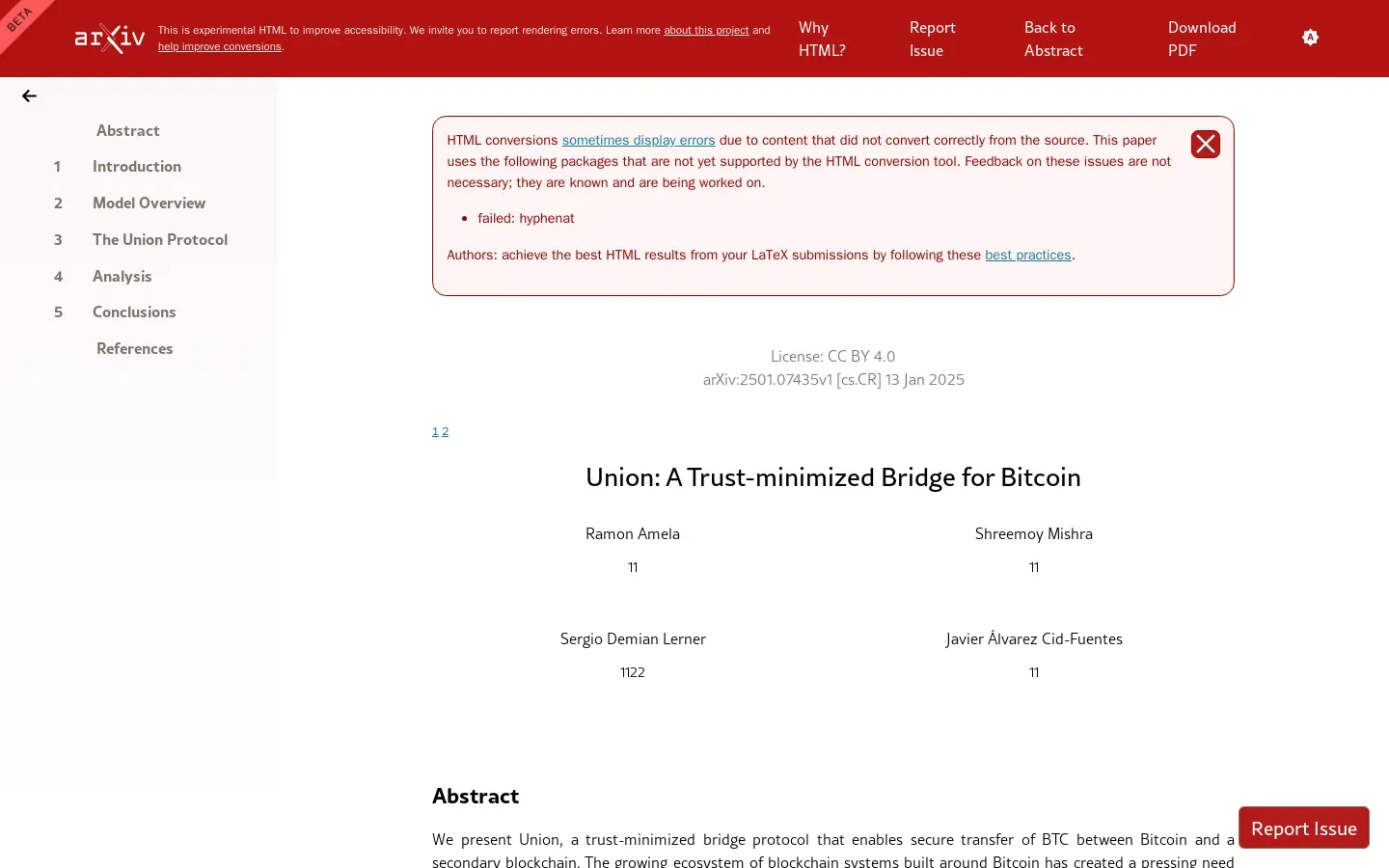
Union Protocol Enhances Bitcoin Interoperability and Security
/ 4 min read
Quick take - The Union protocol is a newly developed framework aimed at improving interoperability between Bitcoin and secondary blockchain systems, enhancing decentralized finance solutions while prioritizing security and scalability.
Fast Facts
-
Union Protocol Overview: A new framework enhancing interoperability between Bitcoin and secondary blockchains, aimed at improving decentralized finance (DeFi) solutions while minimizing trust assumptions.
-
Innovative Architecture: Features a packet-based design that allows shared security deposits, enhancing capital efficiency and reducing costs for cross-chain transactions.
-
Security and Dispute Resolution: Emphasizes robust security mechanisms and includes a dispute resolution framework to manage conflicts during transactions.
-
Cybersecurity Applications: Potential applications include improved fraud detection, automated compliance, interoperable identity management, and enhanced supply chain tracking.
-
Future Prospects: Promising directions for the protocol include interoperable NFT marketplaces and cross-chain asset management, contributing to the evolution of decentralized finance and cybersecurity.
In an era where the digital landscape is evolving at breakneck speed, the need for robust cybersecurity measures has never been more critical. The rise of Cross-Chain Decentralized Finance (DeFi) solutions reflects an ongoing quest for enhanced interoperability, scalability, and security within the blockchain ecosystem. As Bitcoin solidifies its position as a leading cryptocurrency, researchers are unveiling methodologies that aim not only to bolster its utility but also to address significant limitations in its current framework.
The research surrounding the Union protocol is particularly noteworthy. It highlights a structured approach designed to enhance Bitcoin interoperability while maintaining strong security guarantees. A central tenet of this research is the emphasis on security and trust minimization, which seeks to eliminate excessive reliance on third parties while ensuring that protocols remain practical for real-world applications. This is achieved through innovative mechanisms like the Stop Watch Mechanism, which incentivizes functionaries to act honestly until disputes are resolved or peg-out processes are completed.
One of the most compelling aspects of the Union protocol is its packet-based architecture. This design allows multiple bridge operations to share security deposits, significantly enhancing capital efficiency and alleviating economic burdens for participants. By focusing on scalability and practicality, the protocol considers operational costs, network constraints, and implementation complexities—elements often overlooked in traditional blockchain approaches. The implications of these innovations extend far beyond Bitcoin, offering valuable lessons for cybersecurity practices across various sectors.
Another fascinating dimension of this research is its exploration of interoperable identity management systems. As more devices connect to the internet—particularly IoT devices—the need for secure and efficient identity verification becomes paramount. The Union protocol’s adaptability suggests it can be tailored to different secondary blockchain systems, paving the way for a flexible foundation in future blockchain interoperability developments. This adaptability aligns seamlessly with emerging trends in decentralized identity verification, which promise to enhance user privacy while combating fraud.
The study also delves into dispute resolution mechanisms and automated compliance frameworks, emphasizing their role in minimizing risks associated with cross-chain transactions. By implementing enhanced fraud detection systems and resource-efficient models, organizations can better navigate the complex landscape of digital finance without compromising security.
Looking ahead, the potential applications of the Union protocol’s findings are vast. From supply chain management and provenance tracking to automated compliance mechanisms, there are numerous avenues for integrating these insights into real-world cybersecurity scenarios. The intersection of economic incentives and resource efficiency could lead to more resilient systems capable of adapting to ever-evolving threats.
As we consider the future implications of these developments, it becomes evident that creating effective cybersecurity frameworks will require continuous innovation. The lessons learned from the Union protocol not only highlight pathways for improving Bitcoin’s interoperability but also serve as a blueprint for enhancing broader cybersecurity practices across industries. Ultimately, embracing these advancements could usher in an era where decentralized systems operate with enhanced trust, reduced risk, and improved user experience—transforming how we engage with technology in our daily lives.



